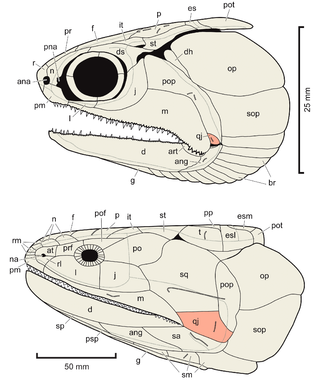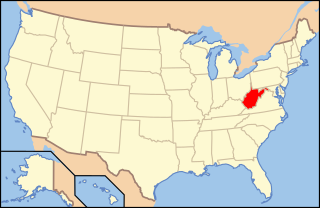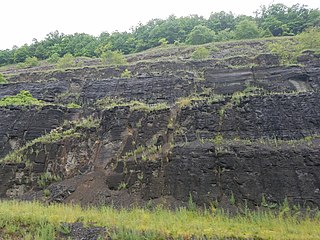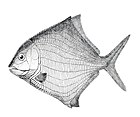
The Bluestone National Scenic River protects a 10.5-mile (16.9 km) section of the Bluestone River in Summers and Mercer counties of southern West Virginia. It was created 26 October 1988 under the Wild and Scenic Rivers Act and is protected by the National Park Service.

Atopocephala is an extinct genus of prehistoric freshwater ray-finned fish that lived during the Middle Triassic epoch. It contains a single species, A. watsoni from the Karoo Supergroup of South Africa. A potential indeterminate species was known from the Timezgadiouine Formation of Morocco, but is now considered an indeterminate actinopterygian.
Helmolepis is an extinct genus of ray-finned fish that lived during the Early Triassic epoch in what is now Greenland, Madagascar and Canada. Species of Helmolepis are small. This genus is closely related with Platysiagum.
Styracopterus is an extinct genus of prehistoric bony fish that lived during the Tournaisian stage of the Mississippian epoch of Scotland and Eastern European Platform, Russia.

Aetheretmon is an extinct genus of prehistoric freshwater and estuarine ray-finned fish that lived during the early Mississippian (Dinantian) age in what is now Europe, including Scotland, Belarus, and Russia. It contains only the species A. valentiacum. This genus has the oldest known actinopterygian growth series, indicating that juvenile Aetheretmon had tails similar to those of modern teleosts, but unlike teleosts, their upper tails continued to grow throughout their lives instead of truncating early. Initially classified as a "palaeoniscid", later studies have recovered it as a stem-neopterygian, or more recently a stem-actinopteran.

Bendenius is an extinct genus of prehistoric marine ray-finned fish. It is known from the Early Carboniferous of Belgium. It was named after Belgian paleontologist Pierre-Joseph van Beneden.

Coccolepis is an extinct genus of prehistoric ray-finned fish in the family Coccolepididae. Originally including most species within the family, it is now restricted to two species from the Late Jurassic Solnhofen Limestone of Germany. The holotype of C. bucklandi, designated and described by Louis Agassiz, was thought to be lost but was later rediscovered in Neuchâtel.
Strepheoschema is an extinct genus of prehistoric bony fish that lived during the early Mississippian (Tournaisian–Visean) in what is now Berwickshire, Scotland, and Northumberland, England. Fossils were recovered from the Ballagan Formation.
Igornella is an extinct genus of prehistoric bony fish that lived during the Gzhelian (Stephanian) to Asselian ages in what is now France (Burgundy).

Mimipiscis is a fossil genus of very primitive ray-finned fishes from the Upper Devonian Gneuda and Gogo formations of Western Australia.

Morrolepis is an extinct genus of prehistoric coccolepidid "palaeoniscoid" ray-finned fish that lived during the Late Jurassic and earliest Cretaceous epochs in Europe, Asia and North America.

Bourbonnella is an extinct genus of prehistoric freshwater and coastal marine ray-finned fish that lived during the late Mississippian (Carboniferous) and Asselian in what is now Burgundy, the Czech Republik, and Utah, with other remains known from elsewhere. The genus was named by Daniel Heyler in 1967.
Guntherichthys is an extinct genus of prehistoric bony fish that lived during the late Mississippian/early Pennsylvanian in what is now Utah, United States. Fossils were recovered from the Manning Canyon Shale. The genus is named after Lloyd Gunther.
Spinofacia is an extinct genus of prehistoric bony fish that lived during the late Mississippian/early Pennsylvanian in what is now Utah, United States. Fossils were recovered from the Manning Canyon Shale.

Paleontology in West Virginia refers to paleontological research occurring within or conducted by people from the U.S. state of West Virginia. West Virginia's fossil record begins in the Cambrian. From that time through the rest of the early Paleozoic, the state was at least partially submerged under a shallow sea. The Paleozoic seas of West Virginia were home to creatures like corals, eurypterids, graptolites, nautiloids, and trilobites at varying times. During the Carboniferous period, the sea was replaced by lushly vegetated coastal swamps. West Virginia is an excellent source of fossil plants due to these deposits. These swamps were home to amphibians. A gap in the local rock record spans from the Permian to the end of the Cenozoic. West Virginia was never the site of glacial activity during the Ice Age, but the state was home to creatures like mammoths, mastodons, and giant ground sloths. One local ground sloth, Megalonyx jeffersonii, was subject to the scholarly investigations of Thomas Jefferson, who misinterpreted the large-clawed remains as belonging to a lion-like predator. In 2008, this species was designated the West Virginia state fossil.

The Bluestone Formation is a geologic formation in West Virginia. It is the youngest unit of the Upper Mississippian-age Mauch Chunk Group. A pronounced unconformity separates the upper boundary of the Bluestone Formation from sandstones of the overlying Pennsylvanian-age Pocahontas Formation.

The Bluefield Formation is a geologic formation in West Virginia. It preserves fossils dating back to the Mississippian subperiod of the Carboniferous period. Sediments of this age formed along a large marine basin lying in the region of what is now the Appalachian Plateau. The Bluefield Formation is the lowest section of the primarily siliciclastic Mauch Chunk Group, underlying the Stony Gap Sandstone Member of the Hinton Formation and overlying the limestone-rich Greenbrier Group.

Guildayichthyidae is a prehistoric family of marine fish from the Mississippian Bear Gulch Limestone of Montana. It is the only family in the order Guildayichthyiformes. Guildayichthyids possess an uncommon mixture of primitive and modern characteristics in their skull bones.
Cladodus is an extinct genus of cartilaginous fishes in the family Ctenacanthidae. As the name implies, they are a type of cladodont, primitive sharks with teeth designed to snag fish and swallow them whole, instead of sawing off chunks to swallow.
Turseodus is an extinct genus of ray-finned fish found in Late Triassic freshwater sediments of the United States. Two species have been described, T. acutus from the Lockatong Formation of Pennsylvania, and T. dolorensis from the Chinle Formation of Colorado.




















